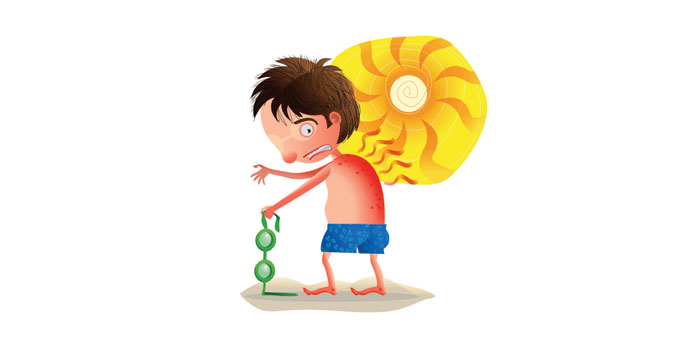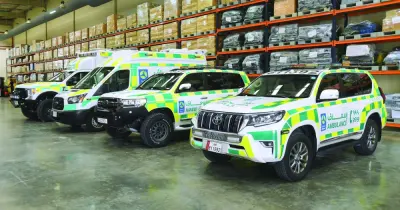By Dr Jameel Sayed
Summer is here, with mercury soaring above 40°C. Skin being the outermost covering of our body bears the maximum brunt of environmental abuses in the form of heat -- UV radiations, humidity, dust and pollution. Skin is the largest organ of our body playing vital roles in various physiological functions of our body. Apart from this, it plays a vital role in cosmetic appearance of an individual.
It is said beauty is skin deep, with skin playing maximum role in the form of its texture, colour, tone etc. With growing awareness for looking good in present times, it is very important for us to know the various factors that affect our skin. We start ageing from the day we are born, sunlight playing a major role in skin changes. Let us see some facts about sunlight.
The sun radiates broad system of energy mainly a) infrared felt as heat b) visible light c) ultraviolet (UV)
Ultraviolet radiation can be divided into 3 bands:
UVA (320 – 400nm) – responsible for immediate tanning, can cause severe sunburn and blistering and in long-term cancer.
UVB (290 – 320nm) – responsible for immediate redness and edema (swelling) and late tanning. Chronic exposure induces most of the changes commonly attributed to ageing and cancer.
UVC (200-290nm) – mainly absorbed by ozone layer and hardly reaches earth.
Approximately two thirds of the total daily UVR reaches earth between 10am and 2pm. Midday UVR is 10% UVB and 90% UVA. Cloud cover reduces the penetration of ultraviolet light (UVL) by 50%. Snow and ice reflect 80% of the radiation, whereas sand reflects 20% and grass 2.5%. So we get more dose of UV in presence of snow and on beaches due to this reflection. The more hydrated the skin becomes (such as after swimming), the less the reflection of UV light and subsequently, increased absorption. Windows glass blocks UVB. Tinted glass can offer protection against UVA. Ozone layer depletion leads to more UVB reaching earth’s surface.
Skin disorders
There are certain diseases which are aggravated by sunlight like SLE, DLE, porphyrias, photodermatitis etc. And there are certain diseases which are induced by sunlight. Let us discuss few common skin problems.
Prickly heat or miliaria is due to blockage of sweat gland ducts in presence of intense and continued heat and humid conditions.
Miliaria cryatillina presents as tiny dots like fluid-filled lesions. It is a mild form miliaria usually asymptomatic and self-limiting if hot condition subsides.
Miliaria rubra is due to exposure to continued hot condition and also due to prolonged fever. It presents as itchy red boils over back, chest, extremities etc.
Treatment is simple, avoiding hot conditions and keeping body cool by having cold water bath. Clothing should be loose cotton clothes. Excess of oily body creams and body oil should be avoided. Use of prickly heat talcum powder is controversial as it can block sweat glands and can aggravate miliaria.
Periporitis (mango boils): This presents as large boils on forehead and cheeks. It is due to miliaria which is secondarily infected. It has nothing to do with mangoes. But since it is seen in summer season which coincides with mango season it is wrongly attributed to mango eating by layperson.
PMLE: Polymorphous light eruptions, is an allergic skin rash to ultraviolet radiation. It presents as various skin features like itchy skin rashes in the form of red patches, scaly areas and even sometimes as blisters. Some present with white scaly patches on cheeks usually perceived amongst common people as calcium deficiency. But these white patches or any other white patches have nothing to do with calcium deficiencies. Lesions are most commonly located on sun exposed areas like face, back of hands, forearm and back of neck and V areas of neck.
Commonly seen those working outdoors are children involved in outdoor sports. Treatment is by local steroid cream and sun protection which will be described later.
Sunburn: Sunburn is skin damage caused by ultraviolet (UV) rays. Due to overexposure to sunlight as in outdoor workers, long beach outing or leisure outing in snow areas.
Mild sunburn: Skin will be tender to touch and cause a hot, taut, drawn feeling. Symptoms usually peak in 16 to 24 hours. Earliest sign is a pink or scarlet hue of skin and swelling. The burn may progress to blistering. Peeling follows during repair process of skin. There can be pigmentation of skin.
Severe sunburn: Intense pain, inability to tolerate contact with clothing and sheets and symptoms like nausea, rapid heart beating, chills and fever. This constellation of symptoms is what lay public calls “sun poisoning .”
Treatment of sunburn
Mild sunburn: Apply cool water compresses for 20 minutes three to four times a day or more frequently. Topical steroid creams may reduce inflammation and pain. Use emollient to soothe and relieve dryness. Aspirin and ibuprofen to relieve pain and discomfort.
Severe sunburn: Requires immediate attention by physician to avoid complications. A short course of oral steroid required apart from above soothing procedures described earlier.
Photoprotection
It usually a misconception amongst lay people about being exposed to sunlight. During day-to-day practice it’s common to hear from patients: “I am not exposed to sunlight” when told that your problem is due to sun exposure. This misconception needs to be broken for general public to realise the importance of sun protection. We are exposed to sunlight even though you walk only few meters from your car to office, you are exposed while driving or even sitting in your office or working in kitchen through windows. Not to forget the ultraviolet radiation from lights, TV screens and various new gadgets.
General measures
Wear loose but closely woven preferably cotton clothes, which covers maximum part of your body. Clothes should be light coloured as dark colour absorbs light and heat.
Wearing a broad brim hat or a cap or carry an umbrella. This gives significant mechanical barrier to sunlight.
Avoiding unnecessary sun exposure by planning your outing at appropriate time of day during summers.
Installing sun protecting films in cars which significantly reduces heat and amount of ultraviolet radiation entering car.
Use of sun screens which are described below.
Drink lot of water and eat coloured fruits and vegetables like carrot, beetroot, papaya and mangoes which are rich in carotenes which act as antioxidants.
Suncreens
Sunscreens are the creams and lotions which give protection against sunlight light reaching the skin when applied. Sunscreens can work by acting physical barriers or protect by chemically absorbing the ultraviolet radiation. Physical sunscreens are better but cosmetically less acceptable. Sunscreens are evaluated by the amount of protection they give when applied by a parameter called SPF (sun protection factor). Higher the SPF, better the protection. But there is a limit. SPF ranges from 2 (minimal protection) to 30+ (highest protection). SPF 2 gives 50% protection, SPF 15 produces 93% protection, and SPF 34 gives 97% protection. Anything beyond this is just hype. Don’t fall to companies claiming SPF 100 as it is senseless. Lighter the skin higher the SPF required. For Indian type of skin, SPF 15 is good enough.
l General consideration while using sunscreen
l Should be applied over all exposed areas including neck, back of neck and ears, which are commonly missed.
l To be applied 15 minutes before going out of house.
l If make-up needs to be applied it can be applied over the sunscreen.
l Those in outdoor sports should use physical sunscreen containing zinc oxide.
Any cream or lotion applied on skin wears off in 3-4 hours due to sweating. So sunscreen needs to apply frequently during the day. Swimming and excessive sweating requires sunscreens to be applied as frequently as every 2 hours. Swimmers should use water resistant sunscreens.
- Dr Jameel Sayed is a Skin Specialist at Aster Medical Centre, C-Ring Road, Doha



